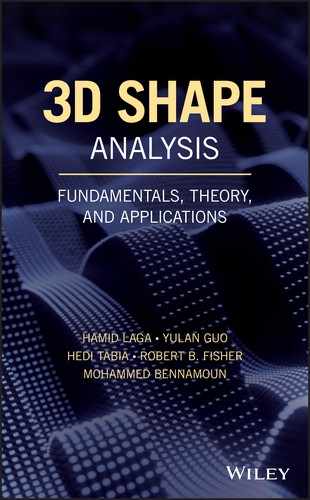Preface
The primary goal of this book is to provide an in‐depth review of 3D shape analysis, which is an important problem and a building block to many applications. This book covers a wide range of basic, intermediate, and advanced topics relating to both the theoretical and practical aspects of 3D shape analysis. It provides a comprehensive overview of the key developments that have occurred for the past two decades in this exciting and continuously expanding field.
This book is organized into 14 chapters, which include an introductory chapter (Chapter 1) and a Conclusions and Perspectives chapter (Chapter 14). The remaining chapters (Chapters 2-13) are structured into three parts. The first part, which is composed of two chapters, introduces the reader to the background concepts of geometry and topology (Chapter 2) that are relevant to most of the 3D shape analysis aspects. It also provides a comprehensive overview of the techniques that are used to capture, create, and preprocess 3D models (Chapter 3). Understanding these techniques will help the reader, not only to understand the various challenges faced in 3D shape analysis but will also motivate the use of 3D shape analysis techniques in improving the algorithms for 3D reconstruction, which is a long‐standing problem in computer vision and computer graphics.
The second part, which is composed of two chapters, presents a wide range of mathematical and algorithmic tools that are used for shape description and comparison. In particular, Chapter 4 presents various global descriptors that have been proposed in the literature to characterize the overall shape of a 3D object using its geometry and/or topology. Chapter 5 covers the key algorithms and techniques that are used to detect local features and to characterize the shape of local regions using local descriptors. Both local and global descriptors can be used for shape‐based retrieval, recognition, and classification of 3D models. Local descriptors can be also used to compute correspondences between, and to register, 3D objects. This is the focus of the third part of the book, which covers the three commonly studied aspects of the registration and correspondence problem, mainly: rigid registration (Chapter 6), nonrigid registration (Chapter 7), and semantic correspondence (Chapter 8).
The last part and its five chapters are more focused on the application aspects. Specifically, Chapter 9 reviews some of the semantic applications of 3D shape analysis. Chapter 10 focuses on a specific type of 3D object, human faces, and reviews some techniques which are used for 3D face recognition and classification. Chapter 11 focuses on the problem of recognizing objects in 3D scenes. Nowadays, cars, robots, and drones are equipped with 3D sensors, which capture their environments. Tasks such as navigation, target detection and identification, and object tracking require the analysis of the 3D information that is captured by these sensors. Chapter 12 focuses on a classical problem of 3D shape analysis, i.e. how to retrieve 3D objects of interest from a collection of 3D models. It provides a comparative analysis and discusses the pros and cons of various descriptors and similarity measures. Chapter 13, on the other hand, treats the same problem of shape retrieval but this time by using multimodal queries. This is one of the emerging fields of 3D shape analysis and it aims to narrow the gap between the different visual representations of the 3D world (e.g. images, 2D sketches, 3D models, and videos). Finally, Chapter 14 summarizes the book and discusses some of the open problems and future challenges of 3D shape analysis.
The purpose of this book is not to provide a complete and detailed survey of the 3D shape analysis field. Rather, it succinctly covers the key developments of the field in the past two decades and shows their applications in various 3D vision and graphics problems. It is intended to advanced graduate students, postgraduate students, and researchers working in the field. It can also serve as a reference to practitioners and engineers working on the various applications of 3D shape analysis.
May 2018
Hamid Laga
Yulan Guo
Hedi Tabia
Robert B. Fisher
Mohammed Bennamoun
